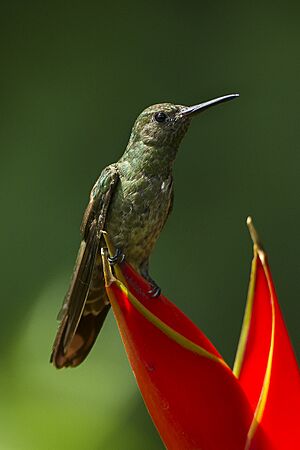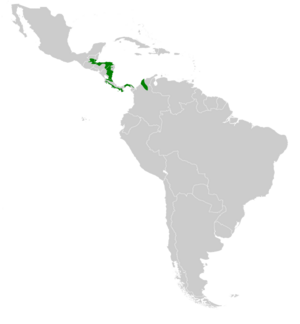Scaly-breasted hummingbird facts for kids
Quick facts for kids Scaly-breasted hummingbird |
|
|---|---|
 |
|
| Conservation status | |
| Scientific classification | |
| Genus: |
Phaeochroa
|
| Species: |
cuvierii
|
 |
|
| Range of P. cuvierii | |
| Synonyms | |
|
Campylopterus cuvierii |
|
The scaly-breasted hummingbird (Phaeochroa cuvierii) is a fascinating bird found in parts of Central and South America. It lives in countries like Belize, Colombia, Costa Rica, Guatemala, Honduras, Mexico, Nicaragua, and Panama. This hummingbird gets its name because the feathers on its chest look a bit like tiny scales. It is also sometimes called the scaly-breasted sabrewing.
Contents
About Its Name and Family
Scientists group animals to understand how they are related. Most experts agree that the scaly-breasted hummingbird belongs to its own special group, called Phaeochroa. However, one big bird organization, BirdLife International, places it in a different group called Campylopterus.
This difference happened because a study in 2014 showed that the Campylopterus group was not as neatly organized as thought. This led to some birds being moved to other groups.
Different Types of Scaly-breasted Hummingbirds
Even within the same species, there can be slight differences. Scientists call these different types "subspecies." The scaly-breasted hummingbird has six known subspecies:
- P. c. roberti
- P. c. maculicauda
- P. c. furvescens
- P. c. saturatior
- P. c. cuvierii (This is the "original" type, called the nominate subspecies)
- P. c. berlepschi
Some scientists have even suggested that P. c. roberti might be a completely separate species!
What It Looks Like
The scaly-breasted hummingbird is about 11.5 to 13 cm (4.5 to 5.1 in) long. That's about the length of a pen. It weighs around 8 to 10 g (0.28 to 0.35 oz), which is very light, like a couple of quarters.
Most of these hummingbirds have a bill (beak) that is mostly black. The bottom part of the bill is often pink. However, the roberti subspecies has an all-black bill. Both male and female birds look very similar, but females usually have a slightly longer bill.
The P. c. cuvierii subspecies is the smallest and lightest in color. It is mostly a shiny bronzy-green. Its belly is a grayish-buff color. The feathers on its belly have light edges, which gives them that "scaly" look. Its tail is mostly bronzy, with white tips on the outer feathers.
How Subspecies Differ
- P. c. roberti has black outer tail feathers with white tips.
- P. c. maculicauda has a greener throat than the cuvierii type. Its outer tail feathers are partly black.
- P. c. furvescens has a darker green throat and upper chest. Its belly is paler than the cuvierii type.
- P. c. saturatior is the biggest and darkest subspecies.
- P. c. berlepschi has a slightly rusty-colored belly. It also has more white on its tail tips.
Where It Lives
The scaly-breasted hummingbird lives in different areas depending on its subspecies:
- P. c. roberti is found in southeastern Mexico and along the Caribbean coast through Guatemala, Belize, Honduras, and Nicaragua, reaching into northeastern Costa Rica.
- P. c. maculicauda lives on the Pacific side of Costa Rica.
- P. c. furvescens is found on the Pacific side of western Panama.
- P. c. saturatior lives on Coiba Island off southwestern Panama.
- P. c. cuvierii is in central Panama, extending east into Guna Yala.
- P. c. berlepschi lives in northern Colombia's Atlántico and Bolívar areas.
This hummingbird likes many types of open or partly open places. You can find it in dry forests, along the edges of humid forests, in mangroves, and even in gardens. It avoids the deep, dark parts of thick forests. It usually stays low to the ground or in the middle parts of trees. In Costa Rica, it can sometimes be found as high as 1,200 m (3,900 ft).
Its Daily Life and Habits
Movement
The scaly-breasted hummingbird usually stays in one area. However, it will move short distances to find flowers that are blooming.
Feeding Habits
This hummingbird drinks nectar from many kinds of flowering trees, shrubs, and bromeliads. It can hover in the air to drink nectar. For bigger flowers, it might even perch (sit) while it feeds. It is quite protective of its favorite flower patches. It will chase away smaller hummingbirds. Besides nectar, it also eats small insects and spiders. It catches them by flying out to grab them in the air or by picking them off plants.
Reproduction and Life Cycle
Scaly-breasted hummingbirds usually breed during the rainy season. This is from May to December in Guatemala and May to January in Costa Rica. Male hummingbirds gather in special spots called leks to show off to females.
The female builds a cup-shaped nest. She uses soft plant material and spiderwebs. She often adds moss and lichen to the outside. The nest is usually placed on a horizontal branch in a small tree. It is typically 2 to 8 m (7 to 30 ft) above the ground. The female lays two eggs. She sits on them for 17 to 19 days. The young birds leave the nest 22 to 29 days after hatching.
Vocalization
The song of the scaly-breasted hummingbird is a loud, changing, continuous warble. It sounds like a mix of chips, sharp squeaks, and short trills. When it chases other birds, it makes a high-pitched, descending trill. Other sounds it makes include a repeated "trrk," a wet "tlek," and a stronger "chick."
Its Conservation Status
The IUCN (International Union for Conservation of Nature) has evaluated the scaly-breasted hummingbird. They have listed it as a species of "Least Concern." This means it is not currently considered endangered or threatened. It lives across a very large area. Scientists believe its population is stable, with at least 50,000 adult birds. No major threats have been found for this species. It is considered uncommon in some places but common in others. It also lives in several protected areas.


